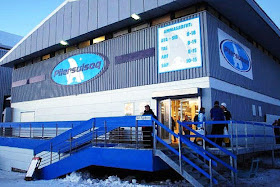Ultima Thule! Utmost Isle! Here in thy harbors for a while We lower our sails; a while we rest From the unending, endless quest
Thursday, 6 February 2014
Wednesday, 5 February 2014
Aasiaat, Greenland
Aasiaat ( danish name Egedesminde) is a town in western Greenland, located on an island in the outermost southern part of Disko Bay.
Population : ~ 4 800, the fourth largest in Greenland.
Coordinates : 68°42′ N, 52°52′ W, some 200 km north of the arctic circle.
The settlement that would become Aasiaat was founded in 1759 by Niels Egede, a norwegian merchant and missionary, as a trading colony for furs, beluga whale, harp seal and narwhal. The traditional hunt was done in kayaks and umiaks, built by the natives.
Fishing ships by the red 'Seaman's home'.
Many houses are reached only by a stairway network leading up and downhill.
Spread out over a rocky island, brightly painted houses and a fishing port make Aasiaat one of the most "greenlandic" settlements in the country.
Aasiaat is also North Greenland's main centre of education with, among others, an upper secondary school and a business school.
The school campus.
Young people in Aasiaat.
Attending the 'Midnigh Sun Marathon'
Today Asiaat is a modern greenlandic town, with Schools, a Hospital, a Museum, sports center, hotels, restaurants and a café. And even shops like Anuni.
The Seaman's Hotel
The Soemandshjem (The Seamen's Home) is located in a tranquil setting with views of the sea and the town in Disko Bay. The oldest buildings date from 1778 and 1826, and served as residences for the whaling station.
In summer it is possible to see whales from the rooms, and in winter the icebergs are a beautiful sight.
Café Puisi
Since 1996
Anuni shop
There are even two supermarkets, Pisiffik and Pilersuisoq
Aasiaat Museum
The Aasiaat Museum was first established in 1978 to house local artifacts.
Egesdesminde, 1879 - Aasiaat Museum
Today, permanent exhibitions include crafts from the local fishing and hunting industries, as well as traditional clothing and handicrafts from the area.
This is small but informative museum, showing how the styles of traditional Inuit clothing change as you move farther north. With focus on Inuit history and the town's past, but also a common hall that is decorated with paintings by Danish painter Per Kirkeby.
An interior wall displays the work of Per Kirkeby.
The old turf house
An outside extension of the museum - an old turf (or peat) house, the kind of huts that were built when Aasiaat was founded: low, rectangular, with walls made of stone and turf on top.
Insulated and robust, it was in use until around 1950.
In present day Aasiaat, things are different; the harbour is visited by the Arctic Umiaq Line coastal ferry, and large merchant ships of the Royal Arctic Line.
Sarfaq Ittuk, the coastal ferry, comes twice a week.
The airport connects to Ilulissat, Nuuk and other smaller towns.
Though small and isolated, Aasiaat found its way. At this latitude it's not easy to find a quality of life as high elsewhere.
Maximum temperature in July can reach over 8º C, the minimum in January as low as -16º C.
Drying clothes in the midnight sun































